ResilSIM—A Decision Support Tool for Estimating Resilience of Urban Systems
Abstract
:1. Introduction
2. Resilience Background
2.1. From Risk to Resilience
2.2. Conception of Resilience
2.3. Defining Resilience Quantitatively
3. Objectives of ResilSIM
4. Method
4.1. Methodological Background
4.1.1. Simulation of the Hazard (Flood Inundation Maps)
4.1.2. Computation of the Disaster Resilience Metric
4.2. Decision Support System Description
4.2.1. User Interface
4.2.2. Database
4.2.3. Mathematical Module
4.2.4. Technical Implementation Details
5. Case Study
5.1. Study Area Description
5.2. Data
- 1—Length of road inundated by the flood (km)
- Number of structures inundated by the flood (no.):
- ○
- 2—Critical facilities
- ○
- 3—Commercial buildings
- ○
- 4—Industrial buildings
- ○
- 5—Residential buildings
- ○
- 6—Engineering infrastructure
- 7—Number of persons younger than 6 or older than 65 (A)
- 8—Number of people who are divorced or widowed (DW)
- 9—Number of single parents (SP)
- 10—Number of migrants (MG)
- 11—Number of allophones—a resident whose first language is neither English nor French (L)
- 12—Number of immigrants (IM)
- 13—Number of visible minorities (VM)
- 14—Number of persons without a high school education (ED)
- 25—Number of unemployed persons (UE)
- 16—Number of families with annual income less than $50,000
- Economic damages incurred ($):
- ○
- 17—Critical facilities
- ○
- 18—Commercial buildings
- ○
- 19—Industrial buildings
- ○
- 20—Residential buildings
- ○
- 21—Engineering infrastructure (unable to compute without stage-damage curves)
5.3. Adaptation Options
5.4. DSS Demonstration
6. Conclusions
Acknowledgments
Author Contributions
Conflicts of Interest
References
- World Bank. Disaster Risk Management: Overview. Available online: http://www.worldbank.org/ (accessed on 1 December 2015).
- Intergovernmental Panel on Climate Change (IPCC). Summary for Policymakers. In Managing the Risks of Extreme Events and Disasters to Advance Climate Change Adaptation, Special Report of Working Groups I and II of the Intergovernmental Panel on Climate Change; Field, C.B., Barros, V., Stocker, T.F., Qin, D., Dokken, D.J., Ebi, K.L., Mastrandrea, M.D., Mach, K.J., Plattner, G.K., Allen, S.K., Eds.; Cambridge University Press: Cambridge, UK; New York, NY, USA, 2012; pp. 1–19. [Google Scholar]
- Intergovernmental Panel on Climate Change (IPCC). 2013: Summary for Policymakers. In The Physical Science Basis, Contributions to Working Group I to the Fifth Assessment Report of the Intergovernmental Panel on Climate Change; Cambridge University Press: Cambridge, UK; New York, NY, USA, 2013; Available online: https://www.ipcc.ch/pdf/assessment-report/ar5/wg1/WGIAR5_SPM_brochure_en.pdf (accessed on 29 August 2016).
- Irwin, S.; Sarwar, R.; King, L.; Simonovic, S.P. Assessment of Climatic Vulnerability in the Upper Thames River Basin: Downscaling with LARS-WG; Water Resources Research Report No. 081; Facility of Intelligent Decision Support, Department of Civil and Environmental Engineering: London, ON, Canada, 2012. [Google Scholar]
- Infrastructure Canada (INFC). Adapting Infrastructure to Climate Change in Canada’s Cities and Communities. 2006. Available online: http://ipcc-wg2.gov/njlite_download.php?id=6305 (accessed on 7 December 2013). [Google Scholar]
- Power, D.J. A Brief History of Decision Support Systems. Version 4.0. 10 March 2007. Available online: http://DSSResources.COM/history/dsshistory.html (accessed on 14 May 2016).
- Rolland, E.; Patterson, P.A.; Ward, K.; Dodin, B. Decision support for disaster management. Oper. Manag. Res. 2010, 3, 68–79. [Google Scholar] [CrossRef]
- Federal Emergency Management Agency (FEMA). Critical Facilities. Available online: http://www.fema.gov/critical-facility (accessed on 30 April 2016).
- Santos-Hernandez, J.; Rodriguez, H.; Diaz, W. Disaster Decision Support Tool (DDST): An Additional Step towards Community Resilience; Disaster Research Centre, University of Delaware Press: Newark, DE, USA, 2008. [Google Scholar]
- Simonovic, S.P.; Peck, A. Dynamic Resilience to Climate Change Caused Natural Disasters in Coastal Megacities Quantification Framework. Br. J. Environ. Clim. Chang. 2013, 3, 378–401. [Google Scholar] [CrossRef]
- Simonovic, S.P. From risk management to quantitative disaster resilience: A paradigm shift. Int. J. Saf. Secur. Eng. 2016, 6, 85–95. [Google Scholar]
- Simonovic, S.P.; Arunkumar, R. Quantification of resilience to water scarcity, a dynamic measure in time and space. In Proceedings of the 7th International Water Resources Management Conference of IAHS ICWRS, Bochum, Germany, 18–20 May 2016; Volume 373, pp. 13–17.
- Kong, J.; Simonovic, S.P. An original model of infrastructure system resilience. In Proceedings of the CSCE Annual Meeting: Resilient Infrastructure, London, ON, Canada, 1–4 June 2016.
- Bruneau, M.; Chang, S.E.; Eguchi, R.T.; Lee, G.C.; O’Rourke, T.D.; Reinhorn, A.M.; Shinozuka, M.; Tierney, K.; Wallace, W.A.; von Winterfeldt, D. A Framework to Quantitatively Assess and Enhance the Seismic Resilience of Communities. Earthq. Spectra 2003, 19, 733–752. [Google Scholar] [CrossRef]
- Folke, C. Resilience: The emergence of a perspective for social-ecological systems analysis. Glob. Environ. Chang. 2006, 16, 253–267. [Google Scholar] [CrossRef]
- Holling, C.S. Resilience and stability of ecological systems. Annu. Rev. Ecol. Syst. 1973, 4, 1–23. [Google Scholar] [CrossRef]
- Pimm, S.L. The Balance of Nature? Ecological Issues in the Conservation of Species and Communities; University of Chicago Press: Chicago, IL, USA, 1991. [Google Scholar]
- World Commission on Environment and Development (WCED). Our Common Future; Oxford University Press: Oxford, UK, 1987. [Google Scholar]
- Brown, K. Global environmental change I: A social turn for resilience? Prog. Hum. Geogr. 2014, 38, 107–117. [Google Scholar] [CrossRef] [Green Version]
- Chang, S.E.; Shinozuka, M. Measuring improvements in the disaster resilience of communities. Earthq. Spectra 2004, 20, 739–755. [Google Scholar] [CrossRef]
- Cutter, S.L.; Barnes, L.; Berry, M.; Burton, C.; Evans, E.; Tate, E. A place-based model for understanding community resilience to natural disasters. Glob. Environ. Chang. 2008, 18, 598–606. [Google Scholar] [CrossRef]
- Sredojevic, D.; Simonovic, S.P. City of London: Vulnerability of Infrastructure to Climate Change. Background Report #2: Hydraulic Modeling and Floodplain Mapping; Water Resources Research Report No. 069; Facility of Intelligent Decision Support, Department of Civil and Environmental Engineering: London, ON, Canada, 2009. [Google Scholar]
- Peck, A.; Bowering, E.; Simonovic, S.P. City of London: Vulnerability of Infrastructure to Climate Change Final Report; Water Resources Research Report No. 074; Facility for Intelligent Decision Support, Department of Civil and Environmental Engineering: London, ON, Canada, 2011. [Google Scholar]
- Peck, A.; Simonovic, S.P. Coastal Cities at Risk (CCaR): Generic System Dynamics Simulation Models for Use with City Resilience Simulator Final Report; Water Resources Research Report No. 083; Facility for Intelligent Decision Support, Department of Civil and Environmental Engineering: London, ON, Canada, 2013. [Google Scholar]
- Armenakis, C.; Nirupama, N. Estimating spatial disaster risk in urban environments. Geomat. Nat. Hazards Risk 2013, 4, 289–298. [Google Scholar] [CrossRef]
- Mijalkovic, S.; Cvetkovic, V. Vulnerability of Critical Infrastructure by Natural Disasters; The Academy of Criminalistic and Police Studies: Belgrade, Serbia, 2010. [Google Scholar]
- Prodanovic, P.; Simonovic, S.P. Development of Rainfall Intensity Duration Frequency Curves for the City of London under the Change Climate; Water Resources Report No. 058; Facility for Intelligent Decision Support, Department of Civil and Environmental Engineering: London, ON, Canada, 2007. [Google Scholar]
- Upper Thames River Conservation Authority. Flooding on the Thames River. Available online: http://thamesriver.on.ca/water-management/flooding-on-the-thames-river/ (accessed on 28 August 2016).
- Water’s Edge Environmental Solutions Team Ltd. Flood Damage Estimation Guide 2007 Update and Software Guide; Ministry of Natural Resources: Peterborough, ON, Canada, 2007.
- City of Toronto. Wet Weather Flow Management Guidelines. Available online: http://www1.toronto.ca/wps/portal/ (accessed on 1 December 2015).
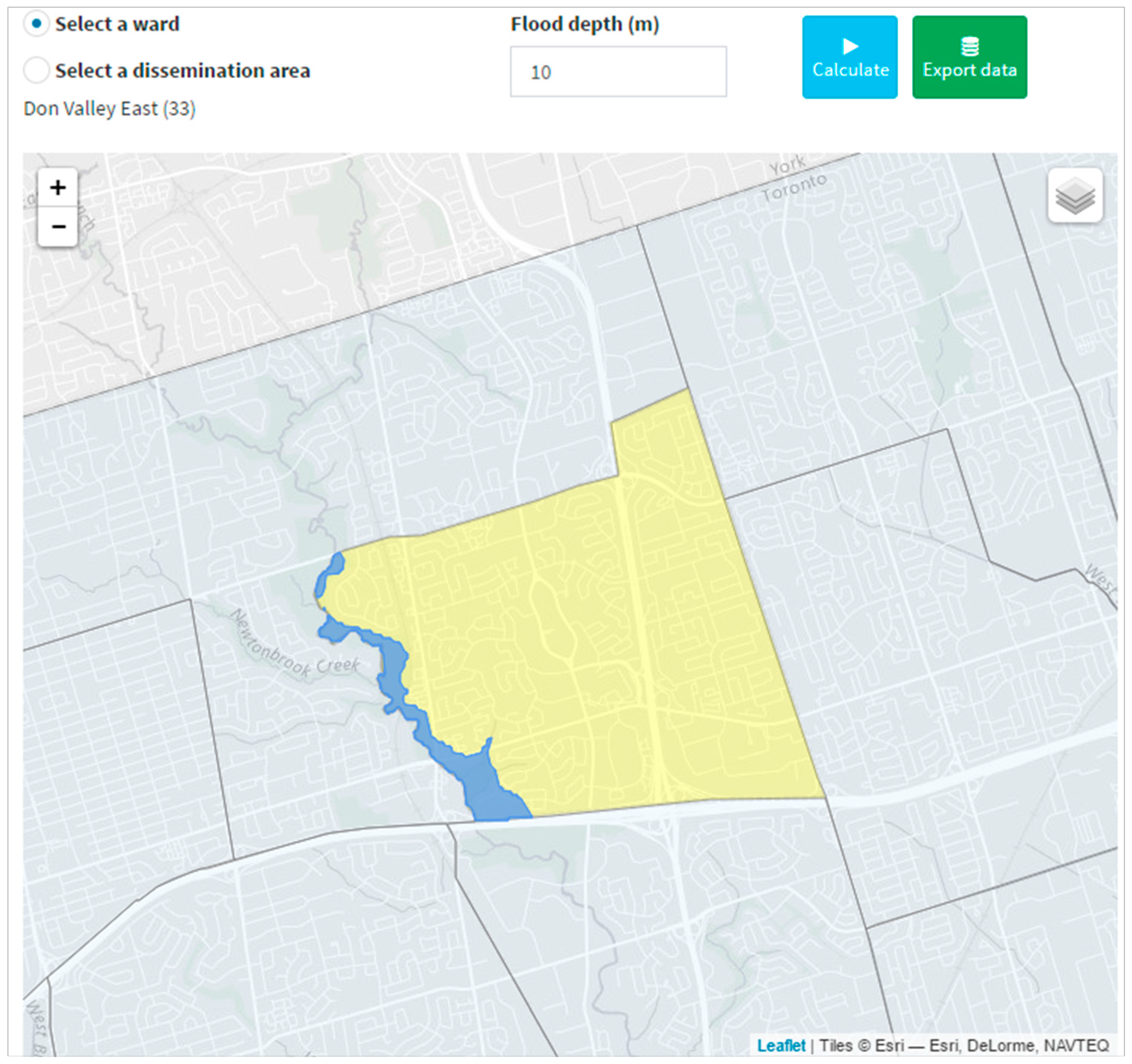
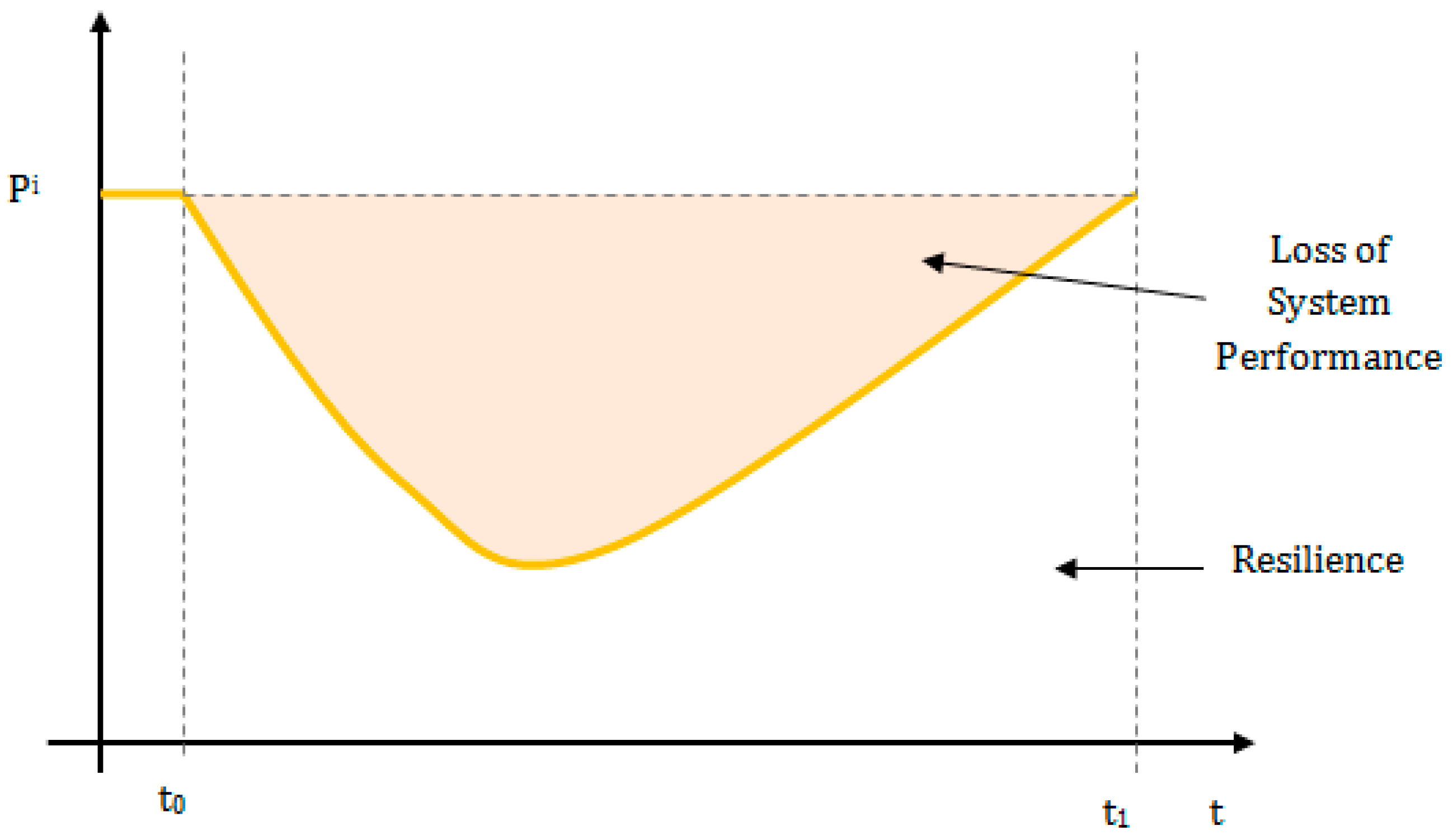
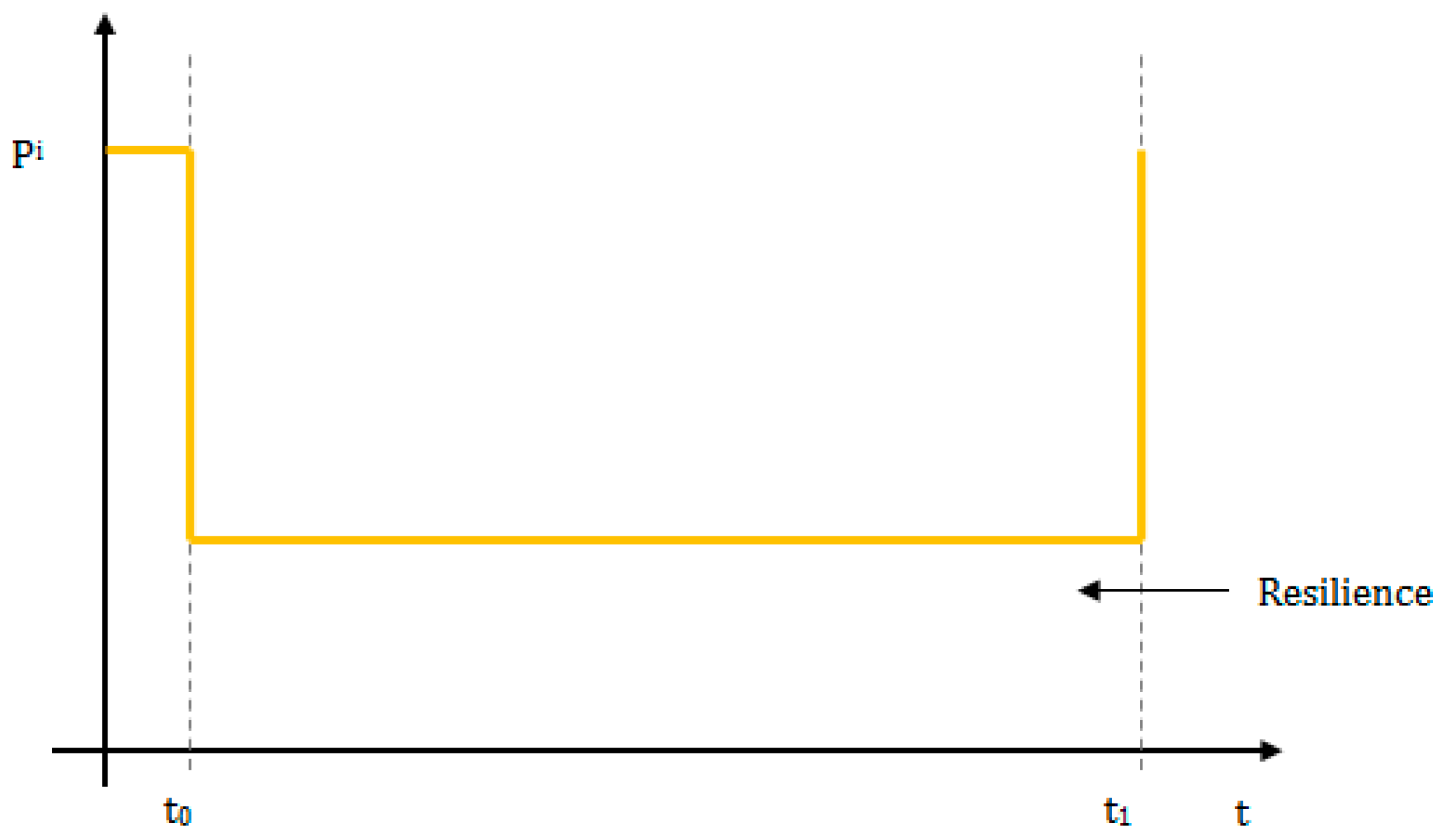
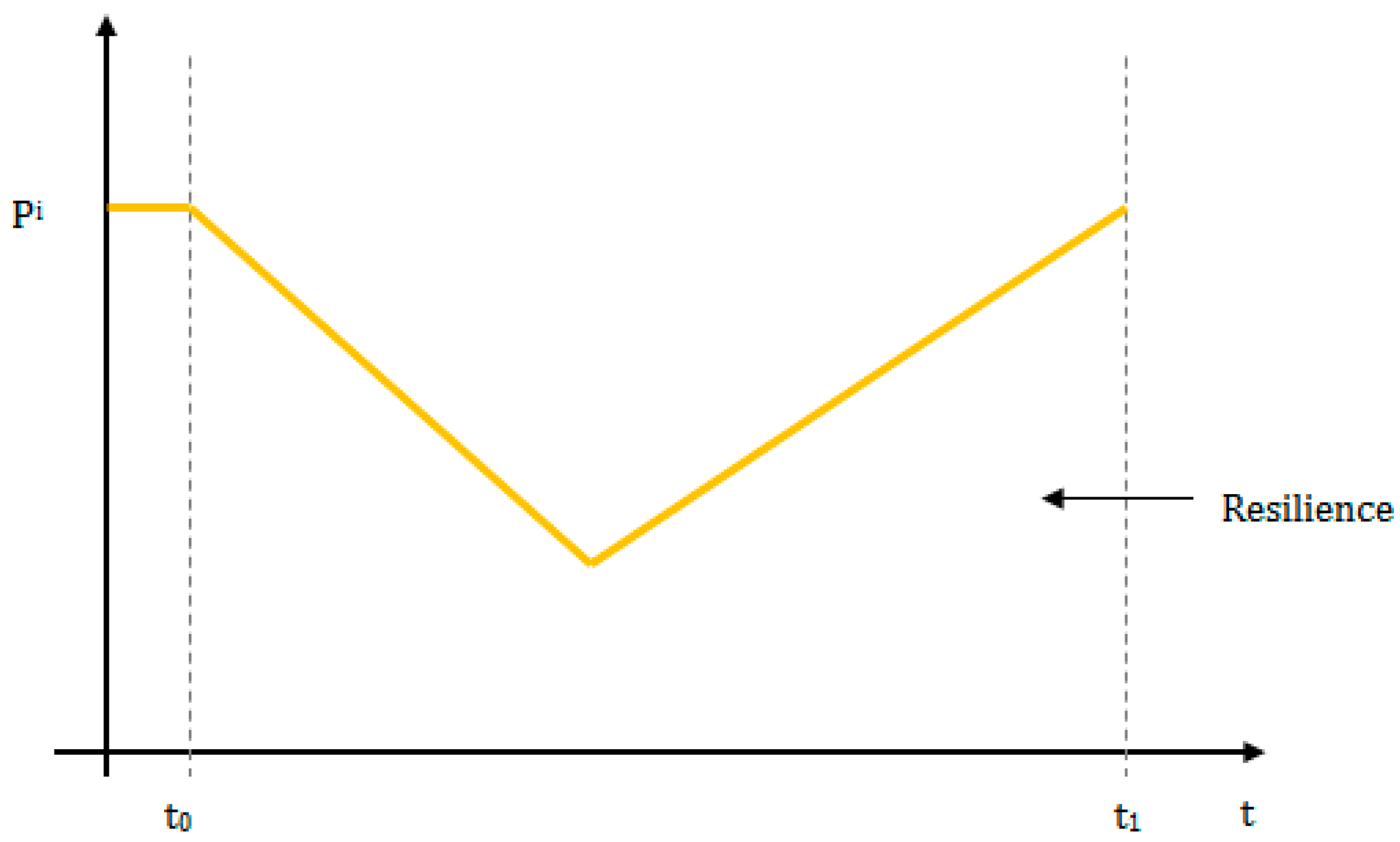



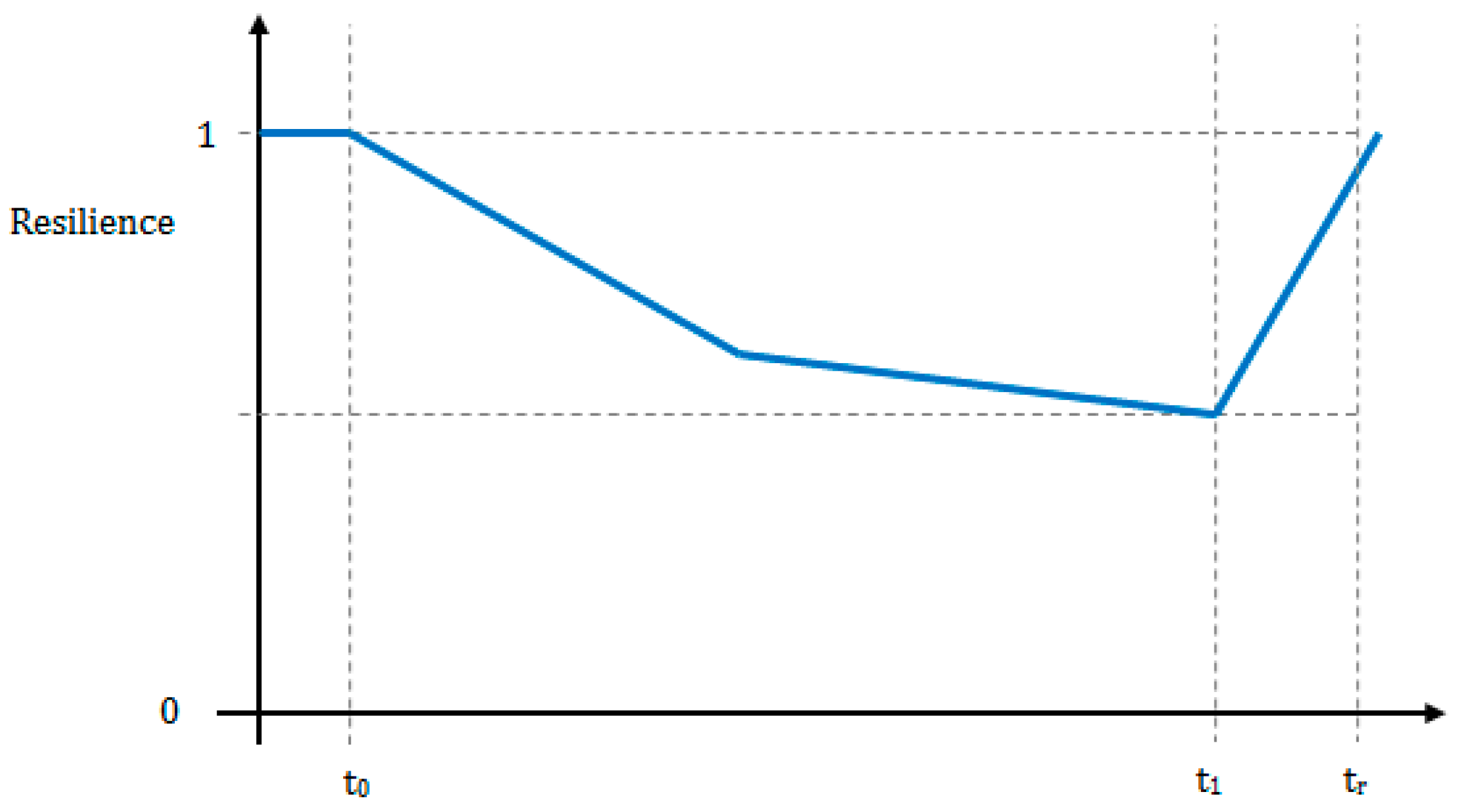


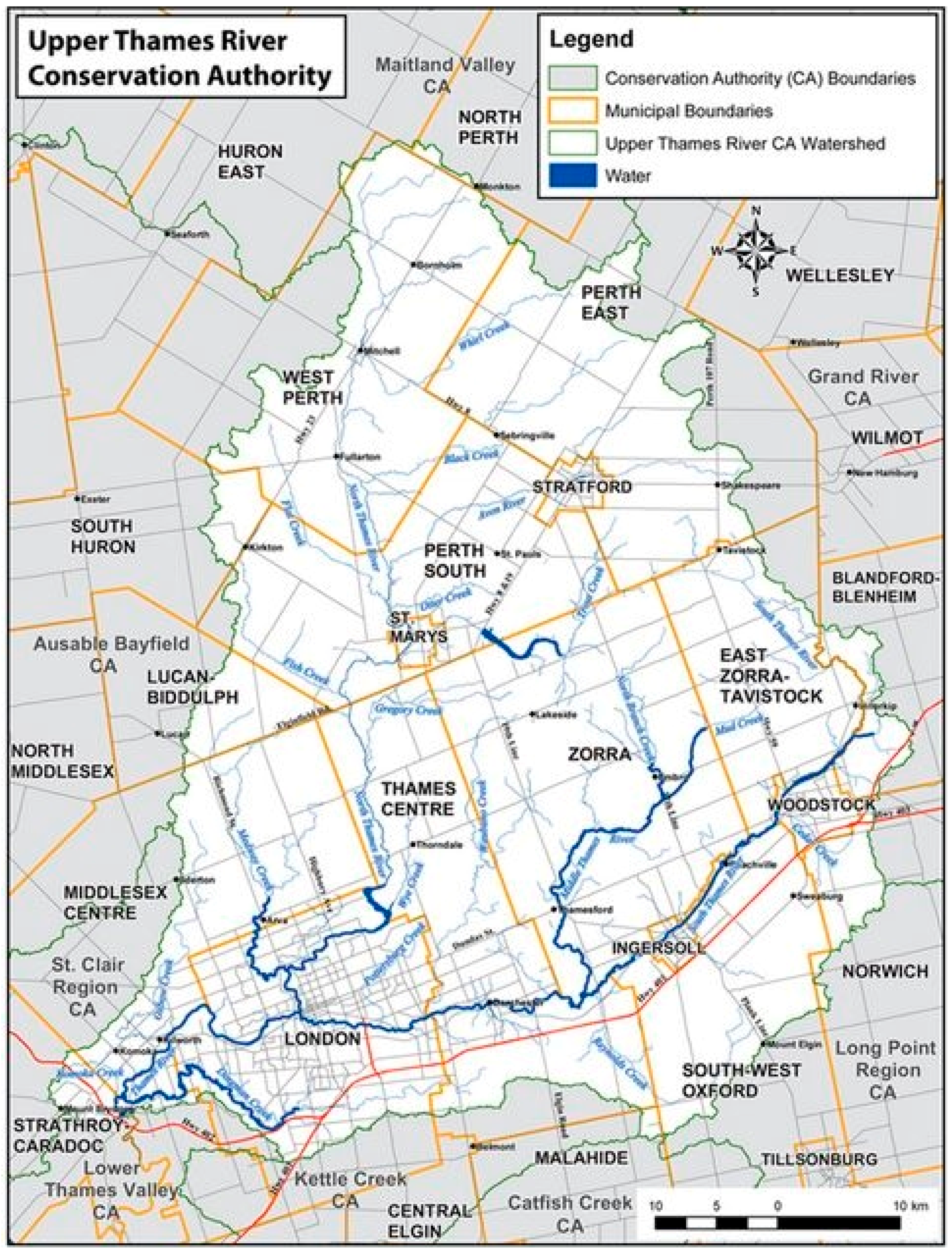
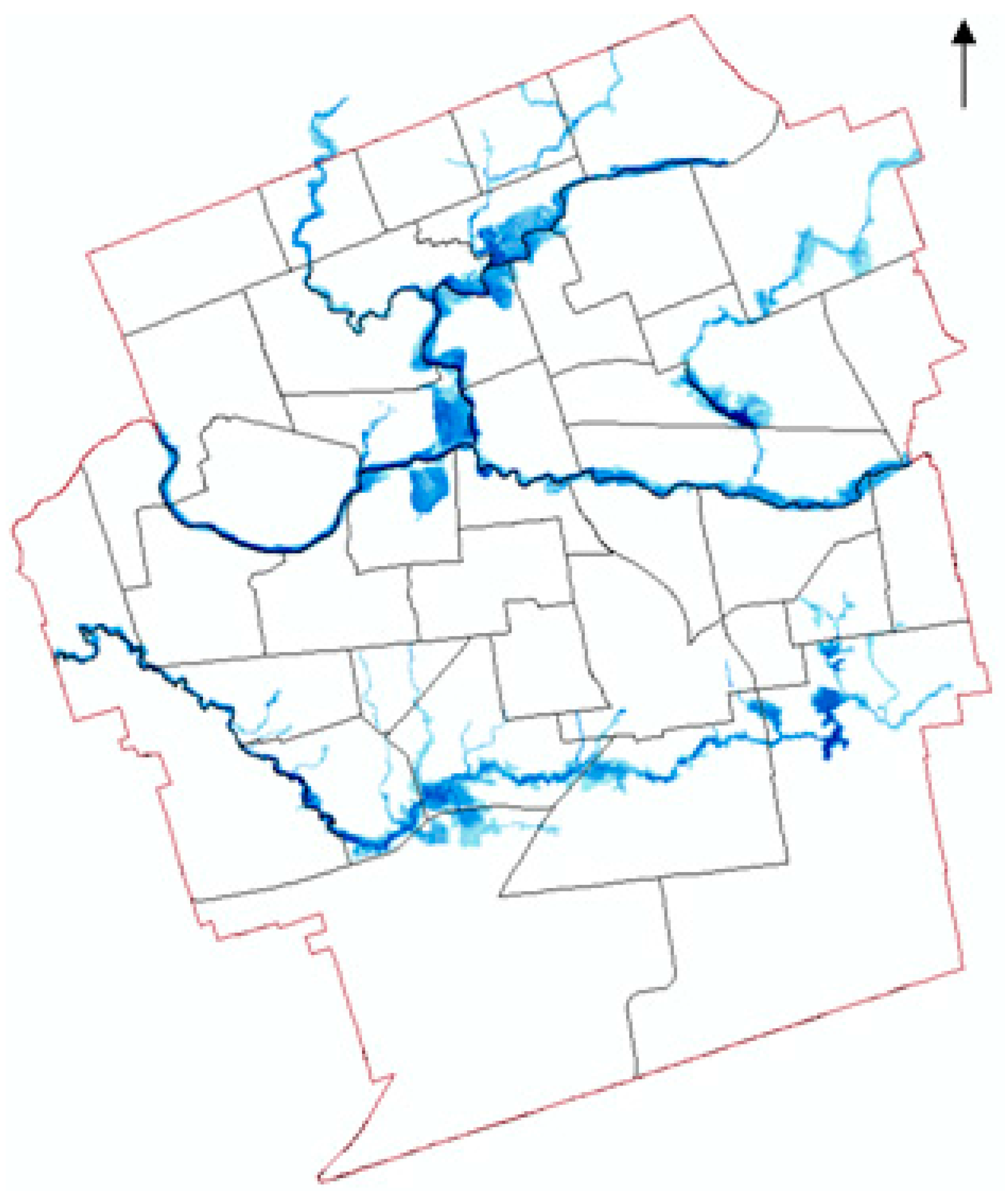
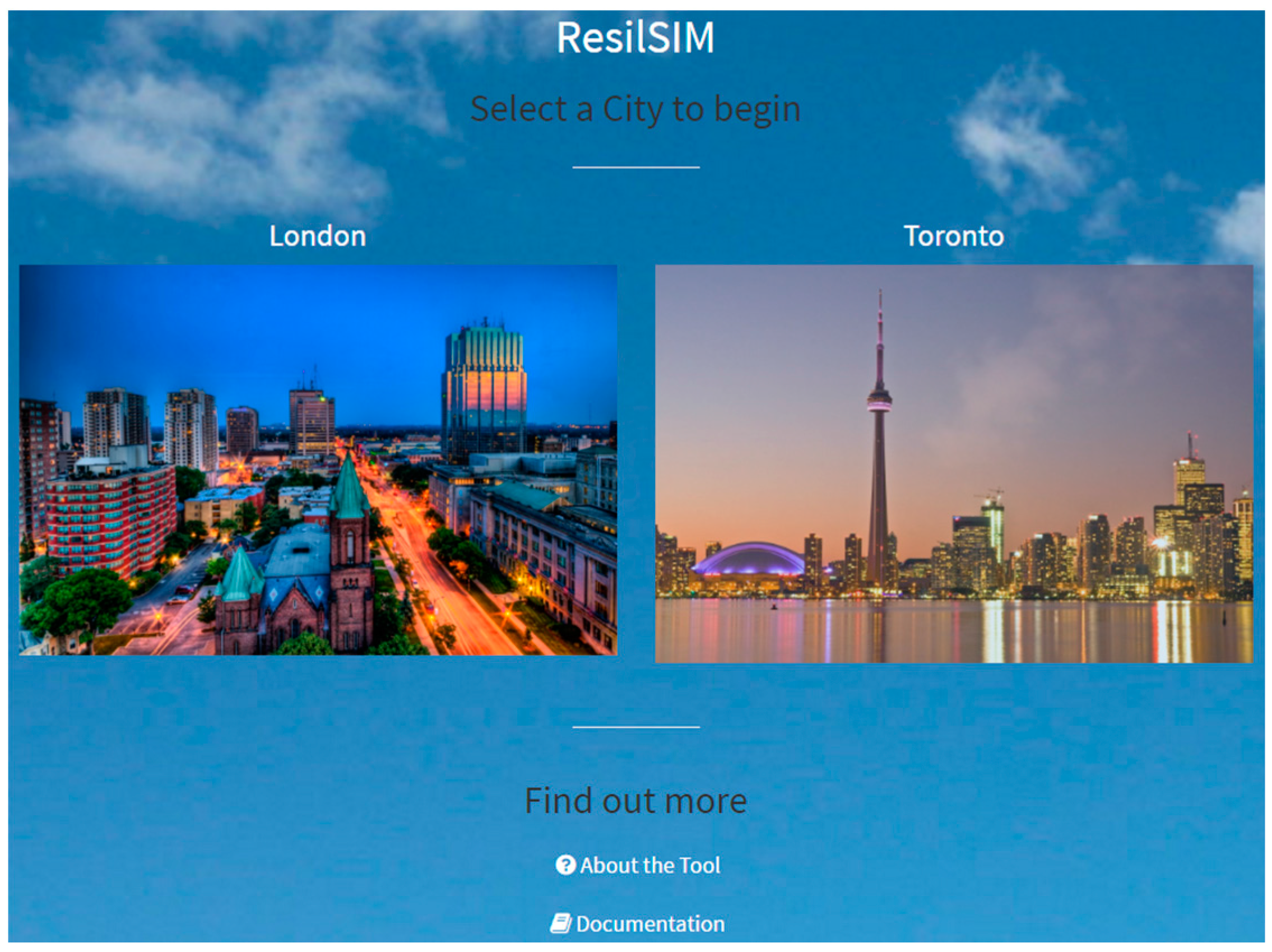
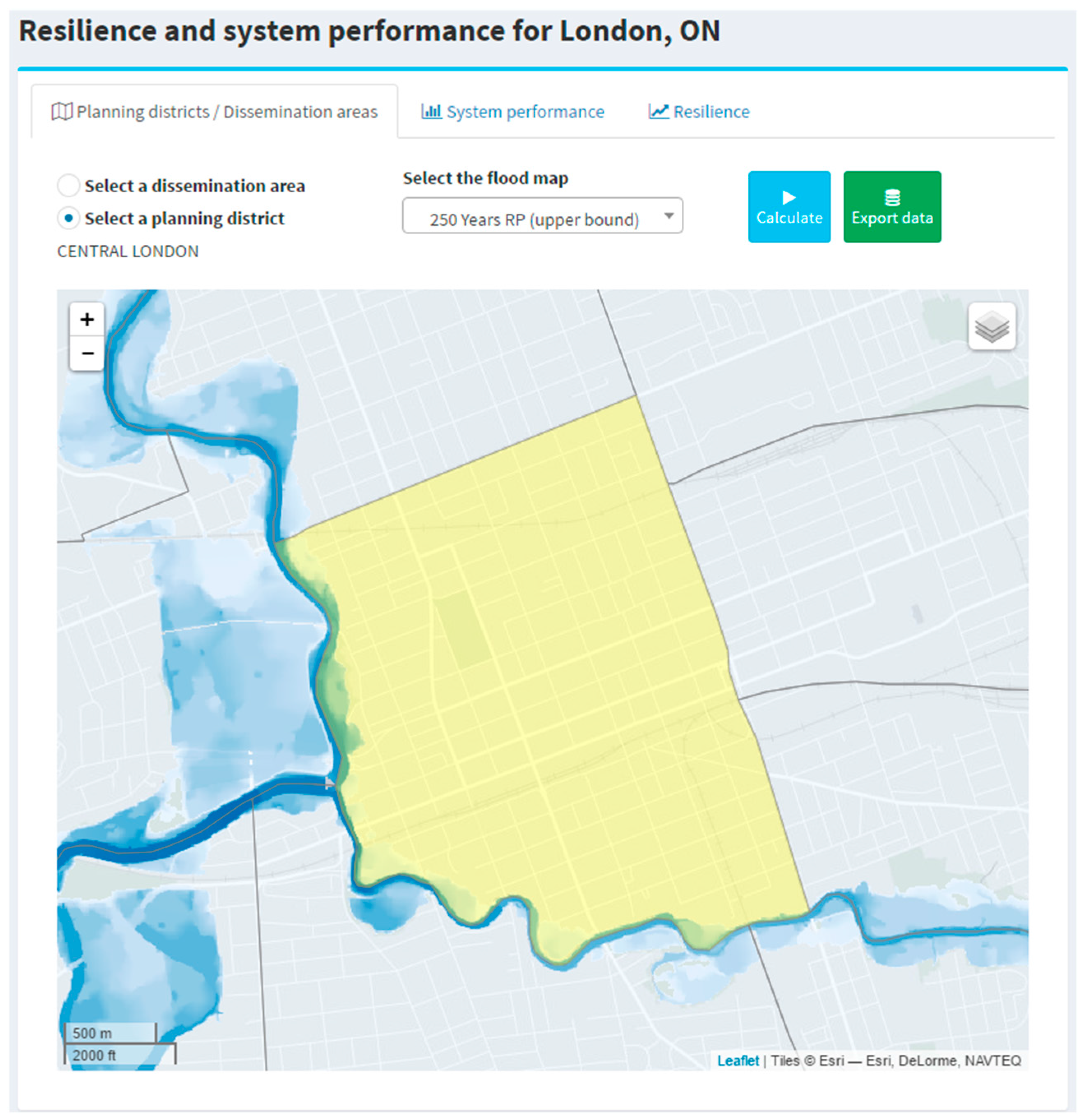
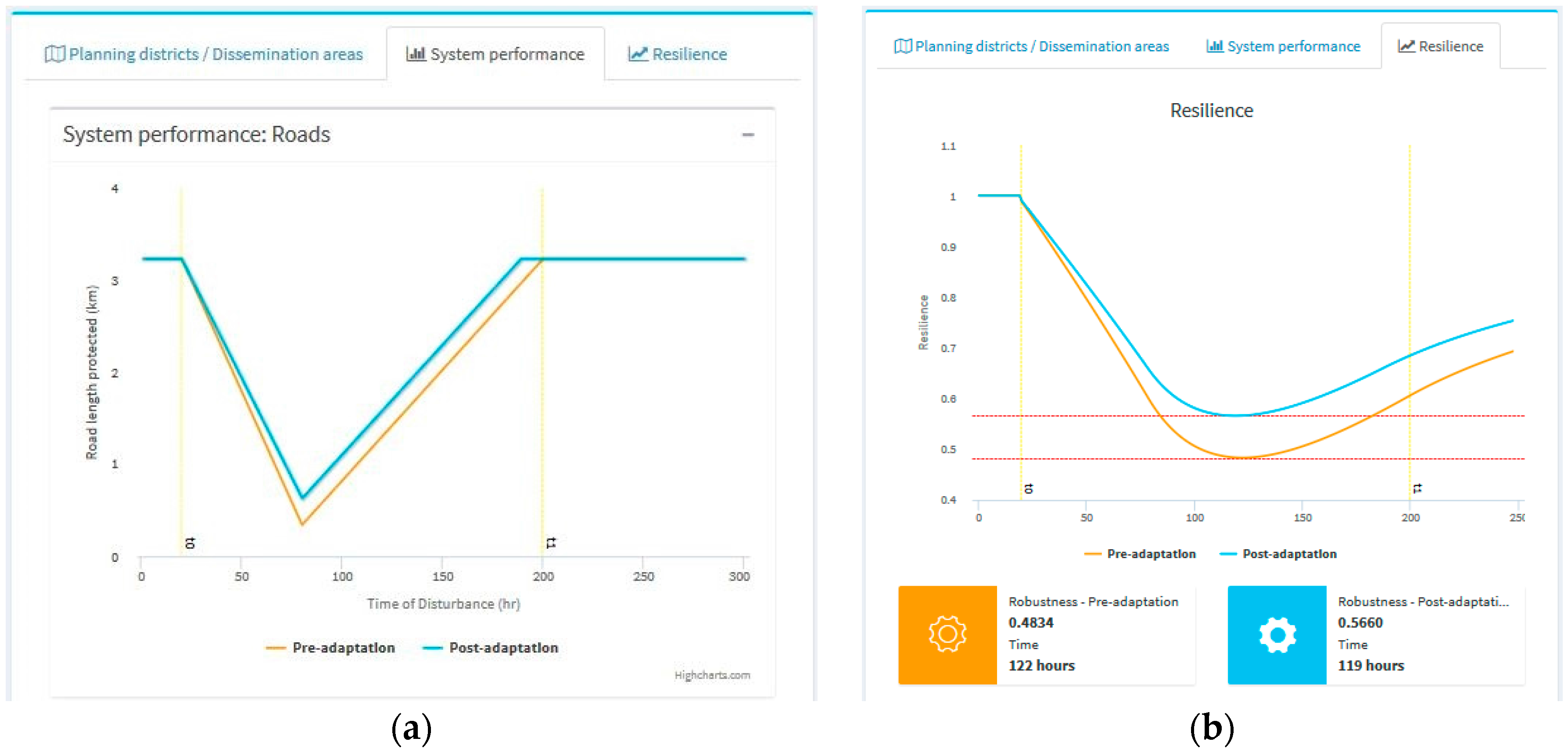
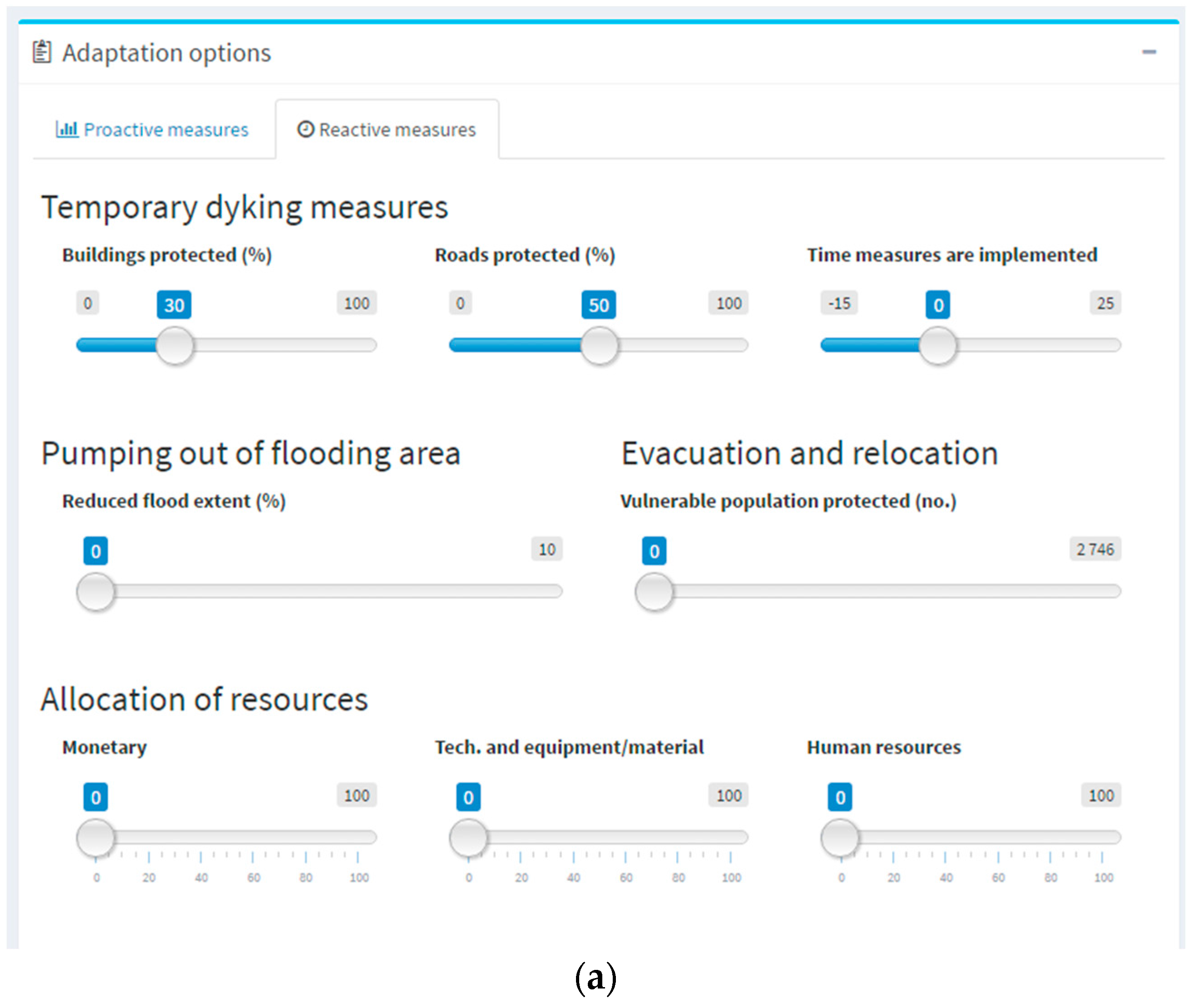

| Dataset | Format | Source |
|---|---|---|
| BUILDINGS (land use) | ||
| Commercial | shape-file | MPAC, City of London |
| Industrial | shape-file | MPAC, City of London |
| Residential | shape-file | MPAC, City of London |
| CRITICAL FACILITIES (description) | ||
| Ambulance Station | shape-file | MPAC, City of London |
| Fire Hall | shape-file | MPAC, City of London |
| Hospital, private or public | shape-file | MPAC, City of London |
| Police Station | shape-file | MPAC, City of London |
| School (elementary or secondary, including private) | shape-file | MPAC, City of London |
| ENGINEERING INFRASTRUCTURE | ||
| Domestic waste facilities | shape-file | CanVec+ |
| Gas and oil facilities | shape-file | CanVec+ |
| Industrial solid waste facilities | shape-file | CanVec+ |
| Pipeline | shape-file | CanVec+ |
| Pipeline (sewage/liquid waste) | shape-file | CanVec+ |
| Power transmission line | shape-file | CanVec+ |
| Railway | shape-file | CanVec+ |
| Road segments | shape-file | CanVec+ |
| Transmission stations/lines | shape-file | CanVec+ |
| VULNERABLE SOCIAL GROUPS | ||
| Unemployed persons | shape, csv-file | StatsCan |
| Families w/ annual income <$50,000 | shape, csv-file | StatsCan |
| Age (<6; >65) | shape, csv-file | StatsCan |
| Single (divorced/widowed) | shape, csv-file | StatsCan |
| Single Parent | shape, csv-file | StatsCan |
| Migrants | shape, csv-file | StatsCan |
| Allophone | shape, csv-file | StatsCan |
| Immigrants | shape, csv-file | StatsCan |
| Visible Minorities | shape, csv-file | StatsCan |
| Persons w/o highschool education | shape, csv-file | StatsCan |
| Category | Adaptation Option |
|---|---|
| Reactive | a. Implementation of temporary dyking measures (e.g., sand bags) to maintain roads and access routes to buildings and critical facilities. b. Pumping out of flooded area—divert floodwater to adjacent open areas such as parks. c. Allocation of resources (monetary, technological, informational, and human resources) to relocate vulnerable people; protect, restore and rebuild vulnerable infrastructure. d. Evacuation and relocation of people belonging to vulnerable social and economic groups. |
| Proactive | e. Implementation of lot-level flood protection measures to prevent floodwater from entering buildings, thereby maintaining structural function. f. Maintenance of drainage infrastructure (through the removal of debris) in order to optimize drainage capacity and reduce the effective flood depth. g. Twinning of critical infrastructure (water and power supplies) such that if one infrastructure piece fails in the event of a hazard, there is a secondary source. |
© 2016 by the authors; licensee MDPI, Basel, Switzerland. This article is an open access article distributed under the terms and conditions of the Creative Commons Attribution (CC-BY) license (http://creativecommons.org/licenses/by/4.0/).
Share and Cite
Irwin, S.; Schardong, A.; Simonovic, S.P.; Nirupama, N. ResilSIM—A Decision Support Tool for Estimating Resilience of Urban Systems. Water 2016, 8, 377. https://doi.org/10.3390/w8090377
Irwin S, Schardong A, Simonovic SP, Nirupama N. ResilSIM—A Decision Support Tool for Estimating Resilience of Urban Systems. Water. 2016; 8(9):377. https://doi.org/10.3390/w8090377
Chicago/Turabian StyleIrwin, Sarah, Andre Schardong, Slobodan P. Simonovic, and Niru Nirupama. 2016. "ResilSIM—A Decision Support Tool for Estimating Resilience of Urban Systems" Water 8, no. 9: 377. https://doi.org/10.3390/w8090377







